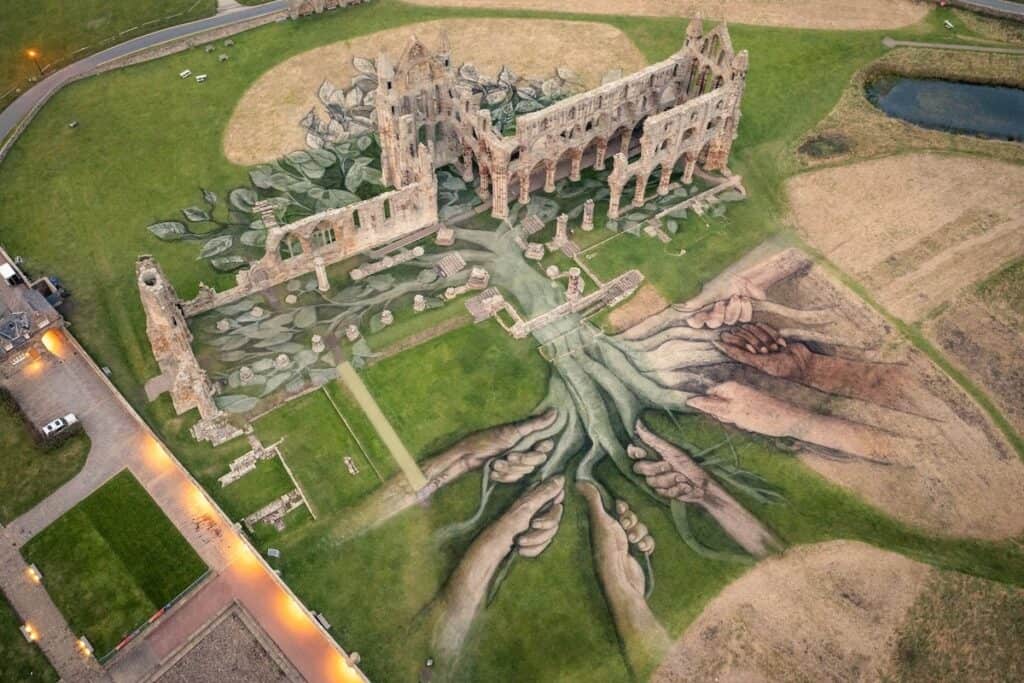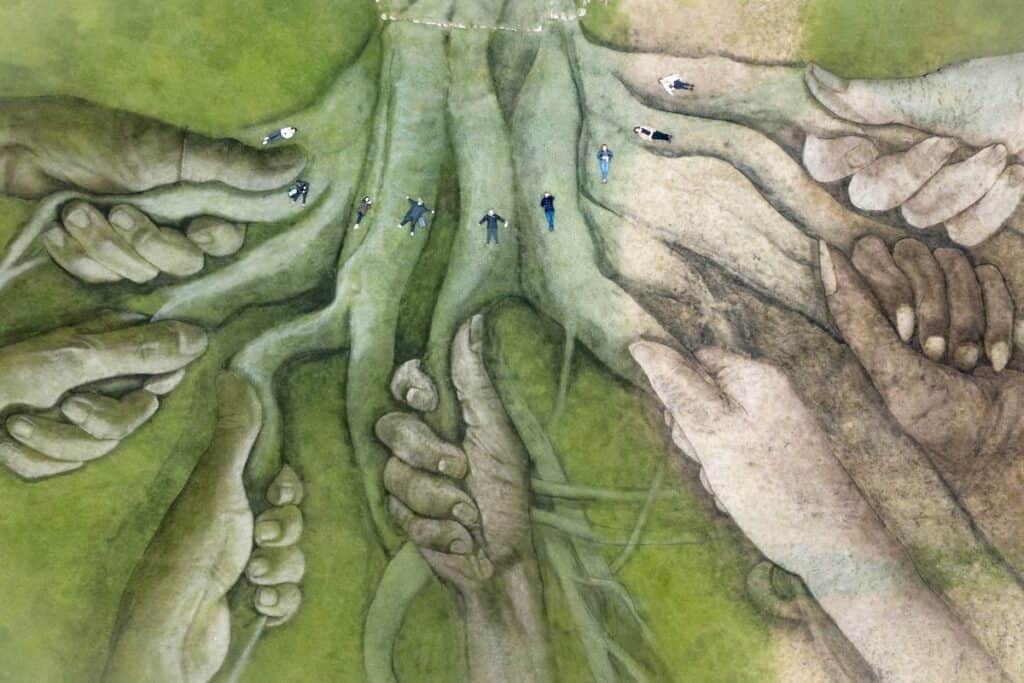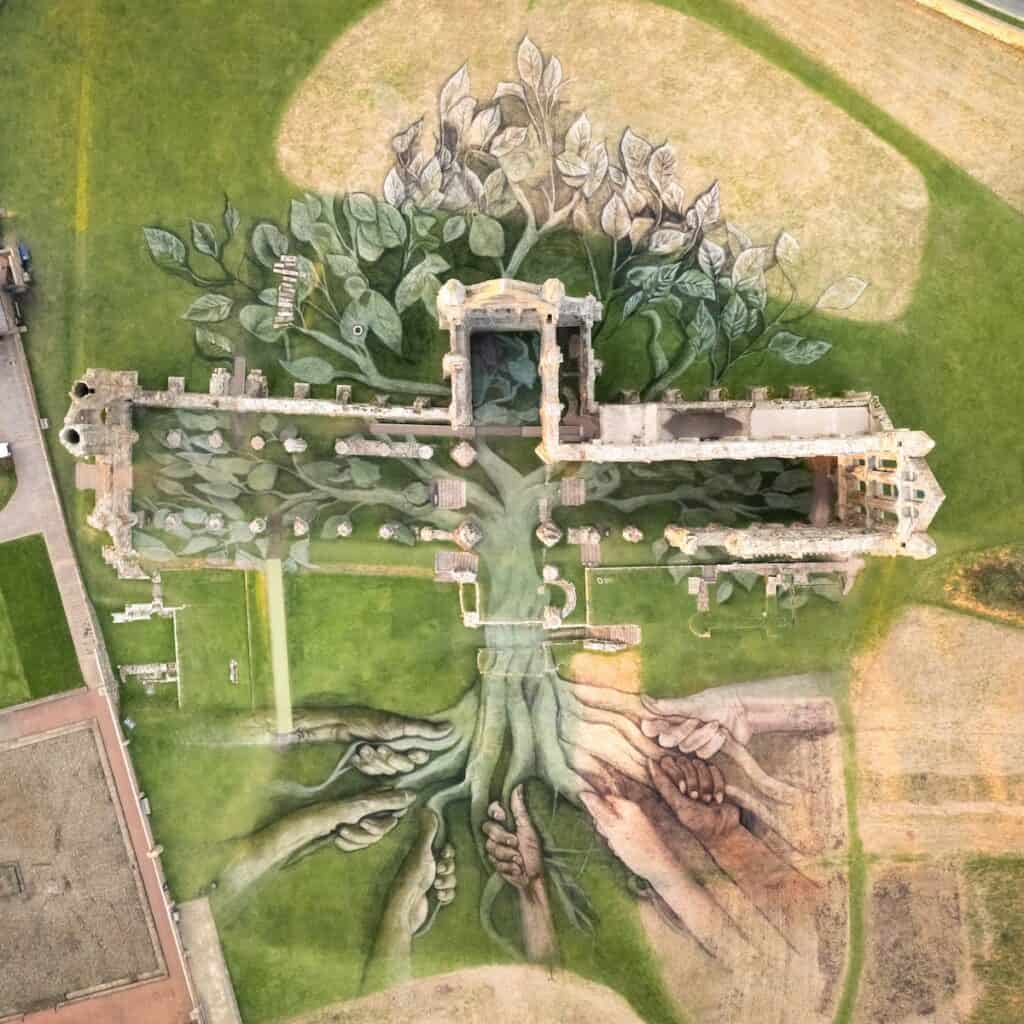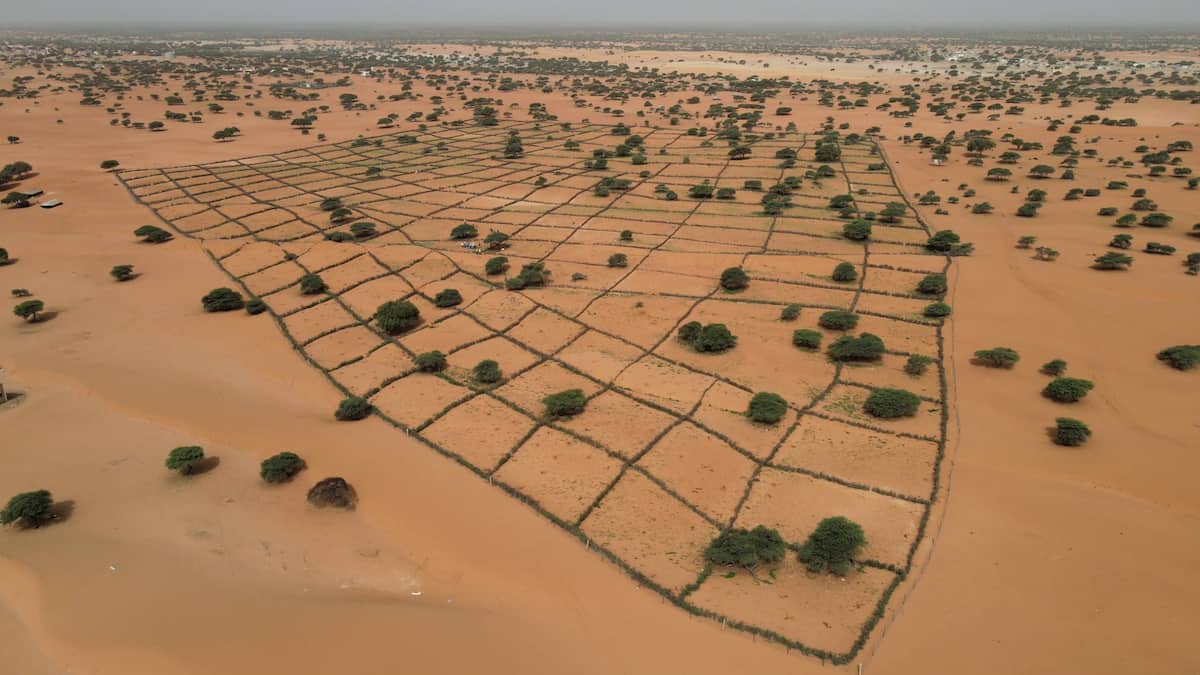
Celebrating people who have changed the game for heritage in the UK, a monumental land art installation has been unveiled on the ground in and around the famous ruins of Whitby Abbey in Yorkshire, England.
Commissioned to mark the 30th anniversary of The National Lottery, the spectacular ‘Heritage Tree’ artwork covers an area the size of four Olympic swimming pools. It sits high on a hill, 199 steps above the harbour of a fishing town almost as famous for its fresh crab as it is for the creation of Bram Stoker’s Dracula.
The land art installation forms part of a programme of events organised by The National Lottery to celebrate the achievements of 30 inspirational Game Changers, in commemoration of the first draw made in 1994.
Selected from candidates nominated by members of the public, these Game Changers are individuals who have achieved amazing things with the help of National Lottery funding over the last three decades.
Enveloping the site of the Abbey managed by English Heritage, the Heritage Tree honours seven such noteworthy people who have significantly changed the game across heritage, land and nature.
The epic installation has been created by renowned land artist David Popa, who used the abbey’s landscape and natural pigments painted on the ground to depict the hands of the Game Changers holding the roots of a tree. Covering a whopping 5,400 square metres, this is the largest work Popa has created to date.
Game Changers across heritage, land and nature

The seven Game Changers who inspired the artwork are:
- Sir Tim Smit, co-founder of The Eden Project: A visionary entrepreneur who transformed a clay pit in Cornwall into a world-renowned ecological attraction to inspire people to reconnect with the natural world, providing a destination visited by millions, contributing over £2.2bn to the South West economy.
- Arthur Torrington CBE, co-founder of the Windrush Foundation: Arthur has travelled the UK collecting the narratives of the Windrush Generation to elevate the Empire Windrush to iconic status.
- Professor Teresa Anderson MBE, Director of Jodrell Bank Centre for Engagement: A British physicist championing science as a form of cultural heritage that tells a story about who we are, leading to Jodrell Bank being recognised as a UNESCO World Heritage site in 2019.
- Chantelle Lindsay, presenter, Project Officer with the London Wildlife Trust and advocate for diversity and inclusivity in wildlife: Passionate about breaking down barriers to nature and inspiring young people and ethnic minorities through initiatives like Kick The Dust, Keeping it Wild, Wildlife Watch videos and appearances on Springwatch and CBeebies’ Teeny Tiny Creatures.
- Sandy Bremner, convener for the National Parks Authority: Leading transformative projects in an area bigger than Luxembourg, Sandy is currently overseeing The Cairngorms 2030 programme, the £10M National Lottery-funded initiative to create the UK’s first net zero national park.
- Lisa Power MBE, trailblazer for LGBTQIA+ rights and Pride Cymru volunteer: Prominent sexual health and LGBTQIA+ rights campaigner dubbed ‘the matriarch of LGBTQIA+ activism’ and co-founder of Stonewall, Lisa was the first openly LGBT person to speak at the UN, and has coordinated the Lottery-funded Icons and Allies Project that unearths and honours LGBTQIA+ figures and allies from Wales.
- Heidi McIlvenny, former project leader for Ulster Wildlife’s Sea Deep initiative: Passionate about sharks since her first encounter as a professional PADI divemaster in Honduras, Heidi launched a first-of-its-kind shark-tagging programme in Northern Ireland to gather vital data about local sharks, skates and rays.
Symbolising deep roots and impact of people
The Heritage Tree was officially unveiled at the start of October by Sir Tony Robinson, one of the most popular faces on UK TV screens regularly seen championing heritage and conservation issues.
The availability of heritage funding is effectively what makes many projects possible, says Robinson:
“Across the spectrum of our heritage and conservation, the impact of the causes and projects championed by these Game Changers is evident — and the role The National Lottery played has been vital.”
Inspirational and impactful, the art truly celebrates the people involved, the individual lives and legacies of the Game Changers, explains Eilish McGuinness, Chief Executive, The National Lottery Heritage Fund:
“Our heritage is incredibly diverse, from archaeology under our feet to the historic parks and buildings we love, from precious memories and collections to sweeping landscapes and rare wildlife.
“At the root of each part of our heritage are people. People who believe in the value of heritage, who dedicate their lives to preserving and enriching it for all to enjoy, people who are game changers for heritage.
“The creation of a stunning ‘Heritage Tree’ installation at Whitby Abbey honours seven of those extraordinary Game Changers and beautifully symbolises the deep roots and ever-growing impact of each.”
Focused on specific areas of National Lottery funding across arts and film, heritage, sport and community, 28 of the 30 Game Changers have been revealed at four installations across September and October.
The final two Game Changers will be announced on TV at The National Lottery’s New Year’s Eve Big Bash.
Largest dedicated funder in the UK
Over the 30 years since 1994, The National Lottery has created more than 7,200 millionaires or multi-millionaires across its games, which amounts to some seven millionaires a week, on average.
However, the primary purpose of the Lottery is giving to good causes and its players have raised more than £49bn in total, with more than 690,000 grants awarded across the UK.
In particular, more than £8.6bn has been awarded by its National Lottery Heritage Fund to support thousands of projects — like those of the Game Changers — since things started back in 1994.
The National Lottery Heritage Fund is now the largest dedicated funder of heritage in the UK. Its vision is for heritage to be valued, cared for and sustained for everyone, now and in the future.
Over the next 10 years, the Fund aims to invest £3.6bn raised for good causes by National Lottery players to benefit people, places and the natural environment. This vision is set out in its strategic plan, Heritage 2033.
Cultural centre since Anglo-Saxon times

As a registered charity, English Heritage cares for over 400 historic monuments, buildings and sites — from world-famous prehistoric places, via grand medieval castles and Roman forts, to Cold War bunkers.
One of the attractions enjoyed by the 10 million visitors to English Heritage sites every year, Whitby Abbey, received over £3.7M from The National Lottery Heritage Fund between 1996-2004.
The Whitby Abbey Headland Project enabled restoration and protection of the natural beauty and historic character of the area, including conservation of the standing remains of the Abbey and other structures.
The ancient Whitby Abbey site has successfully been adapted for 21st-century public use through such measures as the provision of safe access, plus interpretive and educational facilities.
The ruins of Whitby Abbey are among the most celebrated sights of North Yorkshire. Founded around the year 657, the first monastery became one of the most important religious centres in the Anglo-Saxon world.
In 664, it was the setting for the Synod of Whitby, a landmark in the history of the Church in England. The abbey was re-founded after the Norman Conquest as a monastery of the Benedictine order.
The headland is now dominated by the ruins of their abbey church, which was built in the 13th century.
Art out of NYC: from the street to the land

Born and raised in New York City, artist David Popa is based in Finland. His interest in the arts came from his father Albert Popa, who was one of the first graffiti writers in NYC and taught him traditional painting at a young age.
His interests in street art and contemporary muralism are key. His current body of work uses all natural pigments mixed only with the source water to create site-specific, ephemeral earth-works captured through the eye of a drone.
Much of Popa’s large-scale work can be found on islands in the Nordic region. It is documented and portrayed through photography, short films and most recently as non-fungible token (NFTs). Popa is represented by MTart Agency.
Further Reading:
- More about the The National Lottery; and the National Lottery Heritage Fund;
- More about the individual and inspirational Game Changers;
- More about English Heritage; and the Whitby Abbey Headland Project;
- More on renowned land artist David Popa, creator of the ‘Heritage Tree’;
- Also on SustMeme, Conservation boost for endangered Tansy Beetle (also in Yorkshire);
- Also on SustMeme, Crowdsourcing waste clean-up on Mount Everest;
- Also on SustMeme, Green art goes under the hammer;
- Also on SustMeme, Cultural Tourism: Prodigy, or problem child?
Check out the full archive of stories under the SustMeme Biodiversity & Conservation Channel, now available to Sponsor.






